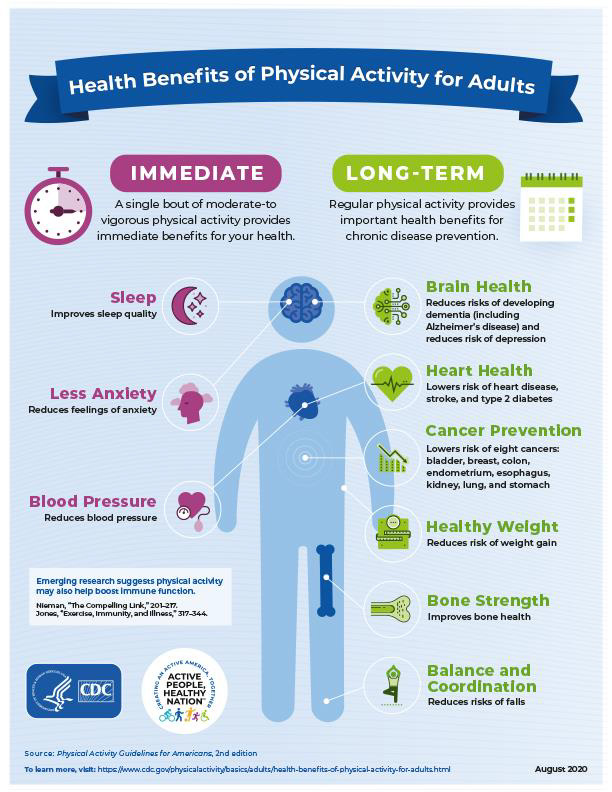Joseph R. Anticaglia MD
Medical Advisory Board
“Exercise is “good for you.” How many times have you heard that? Others announce; you need a “balanced program” that includes muscle strengthening, bone strengthening stretching and aerobic—cardio activities. But how do you make sense of and begin a balanced exercise program? How many steps are enough, what muscle groups should be strengthened or how hard and how often should you work out? People opine about the many benefits of exercise; but what are they?
To answer the above and other questions, every ten years the Department of Health and Human Services (HHS) publishes updated guidelines concerning the benefits of weekly physical activity. The good news; the guideline explains how almost everyone can perform these exercises and feel healthier, without going to the gym.
What Hasn’t Changed in the Guidelines for Adults?
Adults need at least 150-300 minutes of moderate activity each week, such as brisk walking, easy jogging, or swimming leisurely. They also need 75 minutes of vigorous aerobic activity, such as running, jumping rope, bicycling ten miles per hour or faster, tennis or swimming laps.
A person doing moderate-intensity aerobic activity can talk, but not sing, during the activity. A person doing vigorous-intensity activity can’t say more than a few words without pausing for a breath.
The previous guide also recommended that muscle-strengthening activities involve all muscle groups and be done on 2 or more days each week to attain the most health benefits. Strengthening activities include doing push-ups, resistance bands and hand-held weights.
What Has Changed for Adults in the Updated Guidelines?
The latest guidelines note that all activity counts even if done for less than ten minutes. For instance, if your weekly goal is to do 140 push-ups, it’s not required anymore for you to do your physical activity in ten-minute blocks of a time to achieve that goal.
You can break your activity into a few minutes now and a few minutes later (ten push-ups in the morning and ten push up later in the day). At the end of the week, you will have done 20 push-ups per day times 7 or 140 push-ups per week. The benefit is comparable to having done 140 push-ups in 10 minutes. You can apply the same idea to different physical activities.
Benefits of Physical Activity
Physical activity has immediate and long-term benefits. According to HHS, immediate benefits of physical activity include improved sleep and reduced anxiety and stress. Long-term benefits include a reduced risk of cancer, improved brain function and a decreased risk of fall-related injuries in older adults. They are more likely to maintain their weight.
Individuals with chronic conditions have been helped with physical activity. Keeping active can reduce the pain of osteoarthritis, slow down the progression of hypertension and type 2 diabetes.
The Center of Disease Control and Prevention (CDC) used below figures 1 ad 2 to illustrate the benefits of physical activity.


Not everyone can meet the updated guidelines. When ability and fitness levels vary due to medical or physical limitations, individuals should consult their doctor and a physical therapist to work out a program to be as active as feasible.
If you have osteoporosis, avoid high impact exercises such as running, jogging, or jumping rope. These activities can cause fractures. Avoid bending, twisting or jerky movements because people with weakened bones are a risk to fracture their spine.
Many older individuals can benefit from a balance training program to reduce the incidence of falling and injuring themselves. The program might include, for instance, walking heel to toe, standing on one leg, or walking in a figure eight and other activities
If you’re pregnant, moderate physical activity throughout the week is a worthwhile goal. Consult your Obstetrician for guidance.
One-size doesn’t fit all when it comes to fitness programs. Be flexible. It’s necessary to develop a “personal,” practical program to meet your needs Why not stand up and move about after making a telephone call or answering the phone? Or getting up and stretching every 20 minutes if you’re sitting in front of the computer or watching TV for hours? Or getting off the bus one stop ahead of your destination and walking a few blocks?
Any natural movement that causes you to contract your muscles and burn more calories than you would at rest is beneficial to your health. Exercising routinely during the week makes you less dependent on others as you get older and mitigates the risk of you falling and hurting yourself. The takeaway: Keep Moving — Sit Less — Move More!
References
- HHS Releases Physical Activity Guidelines for Americans, 2nd edition November 12, 2018
- World Health Organization; Physical Activity in Adults; July 25,2014
- World Health Organization 2020 guidelines on physical activity and sedentary behaviour
- Office of Disease Prevention and Health Promotion; Top 10 Things to Know About the Second Edition of the Physical Activity Guidelines for Americans
This article is intended solely as a learning experience. Please consult your physician for diagnostic and treatment options.

